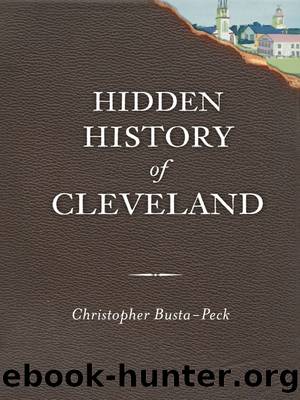Hidden History of Cleveland by Christopher Busta-Peck

Author:Christopher Busta-Peck
Language: eng
Format: epub
Publisher: Arcadia Publishing
Published: 2013-03-15T00:00:00+00:00
THE FIFTY-THOUSAND-TON MESTA PRESS MATTERS
When I first heard about damage to the fifty-thousand-ton Mesta press at the Alcoa Works in Cleveland, it did not seem important, but I followed up by researching the Historic American Engineering Recordâs documentation of the press.
Fifty-thousand-ton Mesta closed die forging press, Alcoa Works, 1600 Harvard Avenue, Cleveland, Ohio (1955). Photograph by Jet Lowe for the Historic American Engineering Record, May 1985. Courtesy of the Library of Congress.
The fifty-thousand-ton Mesta press has been designated a Mechanical Engineering Landmark by the American Society of Mechanical Engineers (ASME), one of about 250 sites worldwide to receive this recognition. Its brochure for the dedication ceremony helps to explain the historical significance of the press in the history of the Cleveland and the aerospace industry:
The Mesta 50,000 ton hydraulic closed die forging press, this countryâs largest forging machine, is currently producing the largest light metal forgings in the world.
This massive forging tool actually had its genesis during the days of World War II. Allied intelligence teams inspecting German aircraft downed behind our lines discovered that they contained extremely large and complex major structural elements. Our appraisal of the situation, confirmed immediately after the end of the war, was that the Germans had produced these aircraft components with the aid of huge forging and extrusion presses possessing capabilities far in excess of those in our own industrial complex.
The implications were far-reaching. If forgings and extrusions large enough to comprise key aircraft structural elements could be produced in this country, not only would fabrication time be reduced greatly, but costs would be lowered. In addition, such a technique held the promise of forging materials with greater strength-weight ratios, an extremely desirable attribute from the standpoint of aircraft design. Just before the conclusion of the war, the United States embarked upon an urgent program to build a press able to match our estimates of the productive capability of the German equipment. The Mesta Machine Company of Pittsburgh was awarded a contract to construct an 18,000 ton forging press, and the Wyman Gordon Company of North Grafton, Massachusetts, was selected to operate it. Since the press was so enormous, a pattern to be followed when the press program went into full swing was establishedâa plant had to be built around the press to house both it and its supporting equipment. The war ended, however, before the project was fully completed.
When our technical/industrial teams visited Germany after the cessation of hostilities, they found that the Germans had indeed developed and learned successfully to operate presses ranging up to 30,000 metric tons. In all, three heavy die forging presses, two with a capacity of 15,000 metric tons and one with a 30,000-ton capacity, were discovered in more or less useable condition. Three extrusion presses in the 5,000 metric ton category were also located. As part of the postwar settlement, the United States acquired the 15,000 and 5,000 metric ton presses which were channeled into the Air Force Heavy Press Program. The 30,000-ton press, however, was seized by the Russians.
Download
This site does not store any files on its server. We only index and link to content provided by other sites. Please contact the content providers to delete copyright contents if any and email us, we'll remove relevant links or contents immediately.
Niceville by Carsten Stroud(2581)
Tokyo by Rob Goss(2022)
Lonely Planet's Guide to Travel Photography by Lonely Planet(1570)
Letter to My Daughter by Maya Angelou(1456)
Arctic Dreams by Barry Lopez(1419)
Ceremony In Death by J D Robb(1241)
Tolkien, J. R. R. - The Fellowship of the Ring by Tolkien J. R. R(1190)
The Source by James A. Michener(1135)
The Lord of the Rings: The Fellowship of the Ring, the Two Towers, the Return of the King by J. R. R. Tolkien(1084)
Nothing to Envy by Barbara Demick(1042)
The Elements of Eloquence by Mark Forsyth(1020)
Epic Hikes of the World by Lonely Planet(1001)
The Price of Salt, or Carol by Patricia Highsmith(974)
African Nights by Kuki Gallmann(968)
The Cities by K.A Knight(924)
Trieste and the Meaning of Nowhere by Jan Morris(842)
The Safe Word by Karen Long(816)
Lonely Planet Epic Drives of the World by Lonely Planet(812)
The Fellowship of the Ring (The Lord of the Rings, Book 1) by J. R. R. Tolkien(804)
